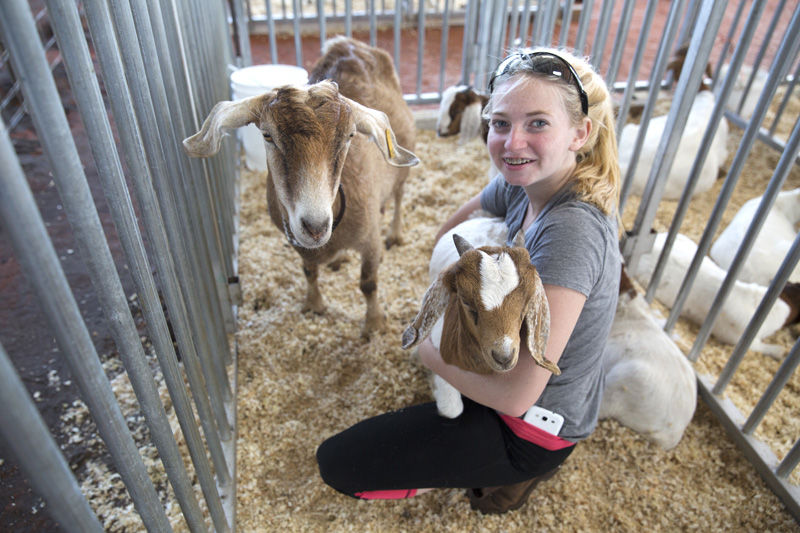The 4-H Club name and logo are instantly recognizable, but outside of agricultural communities, finding people who understand its varied aspects can be as rare as finding a four-leaf clover. The vision often conjured up of children and livestock is certainly one component, but its overall objective has always been youth development.
“The 4-H mission is to create responsible young adults,” explains Christine Kelly-Begazo, University of Florida, County Extension Director/Agricultural Agent. “I look at it as we’re trying to assist the parents to teach their children life skills that will help them be responsible members of our society in the future.”
An estimated 6 million youngsters, ages 5 to 18, participate nationwide. 4-H is funded by the United States Department of Agriculture through land grant universities; in Indian River County through the University of Florida’s Institute of Food and Agricultural Sciences, in partnership with the IRC Board of County Commission.
Projects are interest-based, with a curriculum developed by UF using State of Florida standards, and locally include a wide variety of options – livestock, pets and horsemanship; biological sciences such as embryology, veterinarian, entomology, beekeeping, marine sciences and wildlife; civic engagement; food and nutrition; physical fitness and health; leadership and personal development; aerospace, astronomy, weather; plant sciences, including flowers, vegetables and citrus; and technology and engineering.
“We have the first line-dancing club in all of Florida. So, it’s not just about raising a steer. That’s just an avenue in which to learn life skills such as responsibility, time management and money management. The children pick what kind of project they want to utilize in order to learn these skills,” says Kelly-Begazo.
“It’s changed a lot. It initially started when our lifestyles were agrarian and kids were separated for long periods of time. They had these clubs so that the kids would have socialization. But now we have 4-H in New York City, and those kids of course don’t have animal projects, but they have other things like robotics, aeronautics, science, nursing, crafts; there are over 300 topics.”
“From a parent’s point of view, it teaches the children respect, manners and life skills. Making sure you get up every day and take care your animal, keeping track of the records, or whatever project you might have; it’s a responsibility,” says 4-H parent Tiffany Tripson, a Home Health Coordinator with Nurse on Call.
She and husband Rob Tripson grew up around cattle, and now their 9-year old son Will has a steer as his project. Daughter Isabella, 3, is too young, but Tripson laughs that little Isabella insists she can handle the steer by herself.
A critical requirement is the completion of a project book; tracking details, experiences, what they’ve learned and might have done differently. Because education is an important factor, children must have good grades or have their teacher attest they are putting in an effort. Children also give a presentation to their club to help with public speaking, and must engage in a community service as a club.
“I was a 4-H-er in the county all my life,” says 4-H Extension Agent Lindsay Adams. “I attribute all my work skills, business ethics and my public speaking skills to 4-H. I strongly believe that 4-H is one of the best youth development programs that you can get your children involved in.”
The 4-H Youth Fair Show is always a popular element of the Indian River County Firefighter’s Fair, which runs through March 22. In addition to livestock, there are shooting, citrus tree and whip cracking competitions, baked goods and BBQ contests, and line dancing shows.
“The fair is where, as a reward, they get to show off their project and their hard work,” says Adams.
Youngsters in the livestock program are aware that certain of the animals are slated for “harvesting.”
“That’s not to say they don’t get attached; they do. These animals have personalities,” says Kelly-Begazo. “But this is an agricultural project; they understand that.”
“The kids actually have to do their own marketing; they have to go out and find buyers for their project,” says Adams, noting that through letter-writing and networking with potential buyers, they’re learning public relations and marketing.
“Anywhere you have a large agricultural base in your state, everyone knows that 4-H helps you learn how to be more responsible, how to manage your time, how to stick with something, and that does become important on college applications,” adds Kelly-Begazo .
4-H is currently the only educational option for students interested in agricultural sciences. The Indian River School District eliminated the FFA (Future Farmers of America) program about eight years ago in favor of environmental sciences.
“It’s a shame because we still have such a strong agricultural community,” said Kelly-Begazo. “The wonderful thing about FFA is that it’s actually in the high school, so you select it as a career path. Whereas now we have all of these kids who might want to select agriculture as a career path and there is no support for them whatsoever; none. And that is unfortunate, because who else is going to be growing our food in a few years?”

